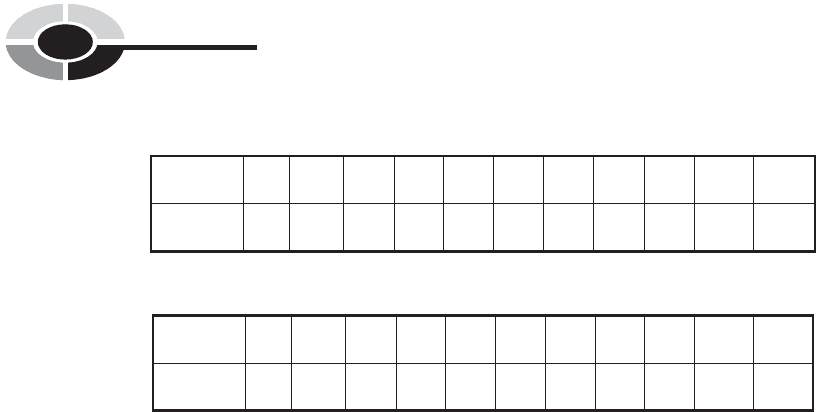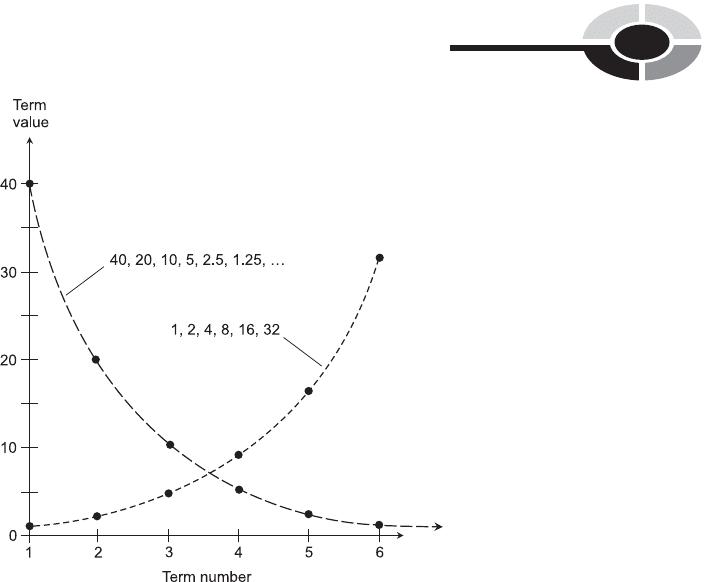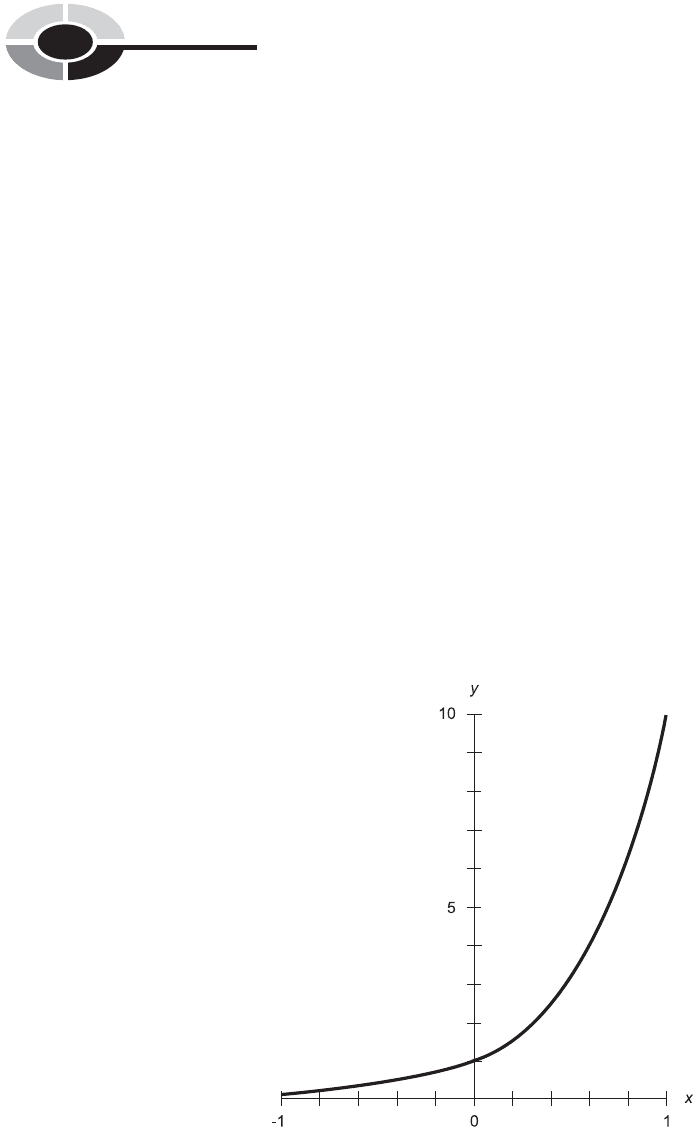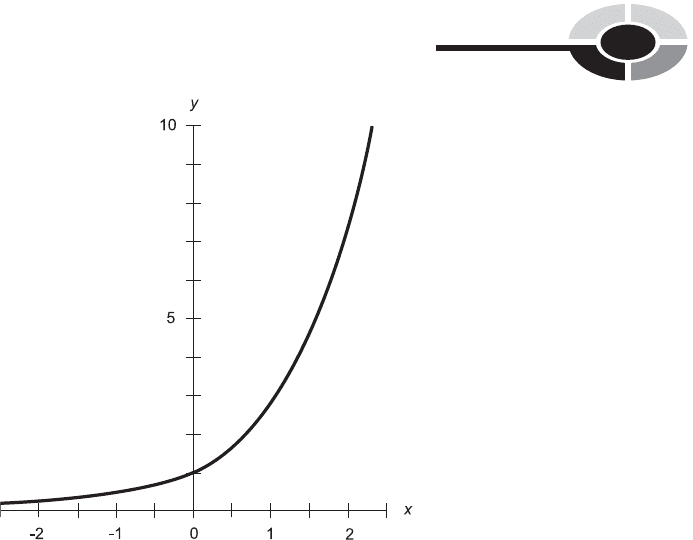Gibilisco S. Everyday Math Demystified: A Self-Teaching Guide
Подождите немного. Документ загружается.


The partial sums denoted by H* and K* don’t settle down on anything. But
the partial sums denoted by L* seem to approach 1. They aren’t skyrocketing
off into uncharted territory, and they aren’t alternating between or among
any multiple numbers. They are under control. The partial sums in L*
seem to have a clear destination that they could reach, if only they had an
infinite amount of time to get there.
CONVERGENT SERIES
It turns out that L
þ
, representing the sum of the infinite string of numbers L,
adds up to exactly 1! We can demonstrate this by observing that the partial
sums ‘‘close in’’ on a value of 1. As the position in the sequence of partial
sums, L*, gets farther and farther along, the denominators keep doubling,
and the numerator is always 1 less than the denominator. In fact, if we
want to find the nth number L
n
in the sequence of partial sums L*, we can
calculate it by using the following formula:
L
n
¼ð2
n
1Þ=2
n
As n becomes large, 2
n
becomes large much faster, and the proportional
difference between 2
n
1 and 2
n
becomes smaller and smaller. When n is
extremely large, the quotient (2
n
1) / 2
n
is almost exactly equal to 1. We can
make the quotient as close to 1 as we want by going out far enough in the
series of partial sums, but we can never make it bigger than 1. The series L
þ
is
said to converge on the number 1, and as such it is an example of a convergent
series.
GEOMETRIC INTERPOLATION
When you see a long sequence of numbers, you can usually figure out, with-
out much effort, whether or not it’s a geometric sequence. If it isn’t immedi-
ately obvious, you can conduct a test: divide each number by the one before
it. If all the quotients are the same, then the sequence is a geometric sequence.
Now imagine, as you did with the arithmetic sequences earlier in this
chapter, that you’re given a long string of numbers, but some of them are
missing. An example of such a situation is shown in Table 14-4. It’s easy to
determine the missing values, once you notice that this is a geometric
sequence in which each term is twice as big as the term preceding it. The 4th
term has a value of 8, and the 9th term has a value of 256. We can call the
process of filling in Table 14-4 an example of geometric interpolation.
CHAPTER 14 Growth and Decay 341

GEOMETRIC EXTRAPOLATION
Just as a geometric sequence can be interpolated, it’s also possible to ‘‘predict’’
what the next numbers are, or would be if the series were lengthened. Table
14-5 illustrates an example of this type of situation. The values in this
sequence are repeatedly cut in half. The 7th number is 1/2. Therefore, the
8th number must be 1/4, the 9th number must be 1/8, the 10th number
must be 1/16, and the 11th number must be 1/32. We can call the process
of filling in Table 14-5 geometric extrapolation.
PLOTTING A GEOMETRIC SEQUENCE
A geometric sequence, like an arithmetic sequence, looks like a set of points
when plotted on a Cartesian plane. Figure 14-3 shows examples of two
geometric sequences as they appear when graphed. (The dashed curves
aren’t actually parts of the sequences.) Note that the dashed curves are not
straight, but they are smooth.
One of the sequences in Fig. 14-3 is increasing, and the dashed curve
connecting this set of points goes upward as you move to the right. Because
this sequence is finite, the dashed curve ends. The other sequence is
decreasing, and the dashed curve goes downward and approaches 0 as you
move to the right. This sequence is infinite, as shown by the three dots at
the end of the string of numbers, and also by the arrow at the right-hand end
of the dashed curve.
If a geometric sequence has a negative factor, that is, if k<0, the plot
of the points alternates back and forth on either side of 0. In this case, the
points fall along two different curves, one above the horizontal axis and
Table 14-4 Another example of a sequence with some intermediate values missing.
The missing values can be filled in by interpolation.
Position: 1st 2nd 3rd 4th 5th 6th 7th 8th 9th 10th 11th
Value: 1 2 4 ? 16 32 64 128 ? 512 1024
Table 14-5 Extension of a geometric sequence can be done by extrapolation.
Position: 1st 2nd 3rd 4th 5th 6th 7th 8th 9th 10th 11th
Value: 32 16 8 4 2 1 1/2 ? ? ? ?
PART 4 Math in Science
342

the other below. If you want to see what happens in a case like this, try
plotting an example. Try setting t
0
¼ 64 and k ¼1/2, and plot the resulting
points.
PROBLEM 14-4
Suppose you get a certificate of deposit (CD) at your local bank for $1000.00,
and it earns interest at the annualized rate of exactly 5% per year. How much
will this CD be worth at the end of 6 years, assuming a constant interest rate?
Round all figures off to the nearest cent at the end of every year.
SOLUTION 14-4
The CD will be worth $1340.10 after 6 years. To calculate this, multiply
$1000 by 1.05, then multiply this result by 1.05, and repeat this process a
total of six times. The resulting numbers are a geometric progression.
*
After 1 year: $1000.00 1.05 ¼ $1050.00
*
After 2 years: $1050.00 1.05 ¼ $1102.50
*
After 3 years: $1102.50 1.05 ¼ $1157.63
*
After 4 years: $1157.63 1.05 ¼ $1215.51
*
After 5 years: $1215.51 1.05 ¼ $1276.29
*
After 6 years: $1276.29 1.05 ¼ $1340.10
Fig. 14-3. Plots of values of the terms in two different geometric sequences.
CHAPTER 14 Growth and Decay 343

PROBLEM 14-5
Is the following sequence a geometric sequence? If so, what are the values t
0
(the starting value) and k (the factor of change)?
T ¼ 3ó 6ó 12ó 24ó 48ó 96ó ...
SOLUTION 14-5
This is a geometric sequence. The numbers change by a factor of 2. Each
number in the sequence is the product of 2 and the number before it. In
this case, t
0
¼ 3 and k ¼2.
PROBLEM 14-6
Is the following sequence a geometric sequence, an arithmetic sequence, or
neither? Is there any pattern to it? If so, what is the pattern?
T ¼ 10ó 13ó 17ó 22ó 28ó 35ó 43ó ...
SOLUTION 14-6
This is not a geometric sequence. It isn’t an arithmetic sequence either. But
there is a pattern. The difference between the first and second numbers is
3, the difference between the second and third numbers is 4, the difference
between the third and fourth numbers is 5, and so on; the difference keeps
increasing by 1 for each succeeding pair of numbers. (Some sequences have
patterns that are subtle indeed. Computers can be helpful in analyzing
such sequences.)
PROBLEM 14-7
Suppose a particular species of cell undergoes mitosis (splits in two) without
fail every half hour, precisely on the half hour. We take our first look at a
petri dish at 12:59 p.m., and find 3 cells. At 1:00 p.m., mitosis occurs for all
the cells at the same time, and then there are 6 cells in the petri dish. At
1:30 p.m., mitosis occurs again, and then there are 12 cells. How many
cells are there in the petri dish at 4:01 p.m.?
SOLUTION 14-7
There are 3 hours and 2 minutes between 12:59 p.m. and 4:01 p.m. This
means that mitosis takes place 7 times: at 1:00, 1:30, 2:00, 2:30, 3:00, 3:30,
and 4:00. Table 14-6 illustrates the scenario. There are 384 cells at
4:01 p.m., just after the 7th mitosis event that occurs at 4:00.
PART 4 Math in Science
344

Exponential Functions
The idea of the geometric progression, in which a value is repeatedly
multiplied by some constant, can be extended into the general realm of
continuous-curve functions. In an exponential function, a constant is raised
to some variable power.
VARIABLE EXPONENTS
Until now, the notion of ‘‘raising something to a power’’ has been kept sim-
ple because we’ve dealt only with whole-number exponents. For example,
when a variable x is raised to the power of 5, we write it as x
5
. When
some constant k is raised to the power of 10, we write it as k
10
. But what
about exponents that are not whole numbers? What, for example, is meant
by the expression x
1.5
or 7
2/3
or z
8/5
? What if an exponent is an irrational
number such as p, the ratio of a circle’s circumference to its diameter?
All scientific calculators, and even some ordinary ones, have a key marked
something like ‘‘x
y
’’ or ‘‘x^y.’’ This is literally read as, ‘‘x to the yth power.’’
To find the value of, say, 3
1.5
, you first enter the number 3, then you hit the
‘‘x
y
’’ or ‘‘x^y’’ key, and finally you enter 1.5. This should give you a result of
5.19615.... To find the value of 3
2.88
, you first enter the number 3, then you
hit the ‘‘x
y
’’ or ‘‘x^y’’ key, and finally you enter 2.88. This will give you
23.6651.... You can even find the value of 3 raised to some power between 0
and 1, or less than 0 (that is, negative).
The general term exponential refers to the raising of a constant to some
power, where that power can be any sort of number. An exponential function
is the raising of a constant to a variable power. Suppose the following
relationship exists among three real numbers a, x, and y:
y ¼ a
x
In this case, x is the independent variable and y is the dependent variable.
The constant a is called the base.
Table 14-6 Table for Problem 14-7.
Time: 12:59 1:01 1:31 2:01 2:31 3:01 3:31 4:01
Number of cells: 3 6 12 24 48 96 192 384
CHAPTER 14 Growth and Decay 345

The two most common exponential-function bases are 10 and the natural
exponential base. The natural exponential base is symbolized by the lower-
case, italicized letter e, and is an irrational number. It is approximately equal
to 2.71828.
COMMON EXPONENTIALS
Base-10 exponentials are also known as common exponentials. For example:
10
3:000
¼ 0:001
Figure 14-4 is an approximate graph of the function y ¼ 10
x
. The domain
of this function encompasses the entire set of real numbers. The range is lim-
ited to positive real numbers only.
NATURAL EXPONENTIALS
Base-e exponentials are also known as natural exponentials. For example:
e
3:000
2:71828
3:000
0:04979
Fig. 14-4. Approximate graph of the common exponential function.
PART 4 Math in Science
346

Figure 14-5 is an approximate graph of the function y ¼ e
x
. The domain
encompasses the entire set of real numbers. The range is limited to positive
real numbers only.
HOW DO WE FIND THEM?
Common and natural exponentials are easy to find. All you have to do is get,
and use, a scientific calculator. The calculator can show us only the first few
digits of the result, so the answer is usually not exact, but it’s a good enough
approximation for most purposes.
Rules for Exponentials
Exponential functions allow us to manipulate numbers in ways that can be
useful in the sorts of work you’re likely to encounter these days. Here are
some of the most common ‘‘laws’’ concerning exponentials. These laws,
like the basic rules of arithmetic, are worth memorizing. That idea is repul-
sive to some folks, but it’s the truth. It is good to know the following rules
by heart.
Fig. 14-5. Approximate graph of the natural exponential function.
CHAPTER 14 Growth and Decay 347

RECIPROCAL OF EXPONENTIAL
Suppose that x is a real number. The reciprocal of the common (base-10)
exponential of x is equal to the common exponential of the negative of x:
1=ð10
x
Þ¼10
x
The reciprocal of the natural (base-e) exponential of x is equal to the natural
exponential of the negative of x:
1=ðe
x
Þ¼e
x
PRODUCT OF EXPONENTIALS
Let x and y be real numbers. The product of the common exponentials of x
and y is equal to the common exponential of the sum of x and y. You might
recognize this rule from all the way back in Chapter 3, when we worked
with power-of-10 notation. When two numbers in scientific notation are
multiplied, the powers of 10 add:
ð10
x
Þð10
y
Þ¼10
ðxþyÞ
The product of the natural exponentials of x and y is equal to the natural
exponential of the sum of x and y:
ðe
x
Þðe
y
Þ¼e
ðxþyÞ
RATIO OF EXPONENTIALS
Let x and y be real numbers. The ratio (quotient) of the common exponen-
tials of x and y is equal to the common exponential of the difference between
x and y. This rule, too, appeared in Chapter 3. When two extreme numbers
are divided in scientific notation, their powers of 10 subtract:
10
x
=10
y
¼ 10
ðxyÞ
The ratio of the natural exponentials of x and y is equal to the natural
exponential of the difference between x and y:
e
x
=e
y
¼ e
ðxyÞ
PART 4 Math in Science
348

EXPONENTIAL OF EXPONENTIAL
Let x and y be real numbers. The yth power of the quantity 10
x
is equal to the
common exponential of the product xy:
ð10
x
Þ
y
¼ 10
ðxyÞ
The yth power of the quantity e
x
is equal to the natural exponential of the
product xy:
ðe
x
Þ
y
¼ e
ðxyÞ
PROBLEM 14-8
Suppose a scientist, Professor P, has developed a theory to the effect that the
world population increases exponentially with time. Imagine that the present
population of the world has been accurately determined, and we assign
this number (whatever it happens to be) the value 100%, or ‘‘exactly 1 popu-
lation unit.’’ Professor P then tells us that every 100 years, the population
increases by precisely a factor of 10, known as an order of magnitude.
Suppose the theory of Professor P is correct, and that the theory remains
valid for millennia to come. What will be the world’s ‘‘people count,’’ in
population units, 100 years from now? What will it be in 200 years? In 300
years?
SOLUTION 14-8
In 100 years (1 century from now), the world’s ‘‘people count’’ will be 10
1
,
or 10, population units. In 200 years (2 centuries), it will be 10
2
, or 100,
population units. In 300 years, it will be 10
3
, or 1000, population units.
This means that in a century, the world will contain 10 times as many people
as it does now; in 2 centuries the world will have 100 times as many people
as it does now; in 3 centuries there will be 1000 times as many people on
the planet as there are today. Let’s hope that Professor P’s theory doesn’t
hold true that long!
PROBLEM 14-9
Write down an exponential equation showing the world population p,in
population units, as a function of time t, in centuries, according to the theory
of Professor P. Assume that t ¼ 0 right now.
SOLUTION 14-9
The equation looks like this:
p ¼ 10
t
CHAPTER 14 Growth and Decay 349

You can check this out by plugging in values for t.Ift ¼ 0, then p ¼ 10
0
¼ 1.
If t ¼ 1, then p ¼ 10
1
¼ 10. If t ¼ 2, then p ¼ 10
2
¼ 100. If t ¼ 3, then
p ¼ 10
3
¼ 1000. These results agree with those obtained in Solution 14-8.
PROBLEM 14-10
According to the theory of Professor P, how many people, in population
units, will inhabit the world 150 years from now?
SOLUTION 14-10
To solve this problem, we use the equation from Solution 14-9, and plug
in the value t ¼ 1.5. This gives us a population p as follows:
p ¼ 10
1:5
How do we calculate the value of an expression like 10
1.5
? It’s easy if
you have a scientific calculator that includes exponential functions. Use the
‘‘x
y
’’ or ‘‘x^y’’ key. Your calculator might also have a ‘‘10
x
’’ key. In any
event, you should obtain the value p ¼ 31.62, which we can round off to
32. This means that in 150 years, according to the theory of Professor P,
the world population will be 32 times as great as it is right now.
Logarithms
A logarithm (sometimes called a log) is an exponent to which a constant is
raised to obtain a given number. Suppose the following relationship exists
among three real numbers a, x, and y:
a
y
¼ x
Then y is the base-a logarithm of x. This expression is written
y ¼ log
a
x
The two most common logarithm bases are 10 and e, the same as the
exponential bases.
COMMON LOGARITHMS
Base-10 logarithms are also known as common logarithms or common logs.
In equations, common logarithms are denoted by writing ‘‘log’’ without a
subscript, or occasionally ‘‘log’’ with a subscript 10. For example:
log 100 ¼ log
10
100 ¼ 2:00
PART 4 Math in Science
350
